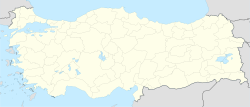إزنيق
إزنيق İznik | |
|---|---|
 المسجد الأخضر، إزنيق | |
 أقضية محافظة بورصة | |
| الإحداثيات: 40°25′45″N 29°43′16″E / 40.42917°N 29.72111°E | |
| البلد | تركيا |
| المحافظة | بورصة |
| الحكومة | |
| • العمدة | قدري إريلماظ (AKP) |
| • قائمقام | نور الدين كاكليأوغلو |
| المساحة | |
| • District | 736٫51 كم² (284٫37 ميل²) |
| التعداد (2012)[2] | |
| • Urban | 22٬507 |
| • District | 43٬425 |
| • كثافة District | 59/km2 (150/sq mi) |
| Post code | 16860 |
| الموقع الإلكتروني | www.iznik.bel.tr |
إزنيق İznik، وكانت تاريخياً تُعرف بإسم نيقيا (Nicaea ؛ باليونانية: Νίκαια)، هي بلدة و قضاء إداري في محافظة بورصة، تركيا.[3] The town lies in a fertile basin at the eastern end of Lake İznik, bounded by ranges of hills to the north and south. مسافة الخط المستقيم بين إزنيق واسطنبول هي 90 كم جنوب شرق اسطنبول but by road it is 200 km (124 miles) around the Gulf of Izmit. وتبعد 80 كم بالطريق عن بورصا.
The town was an important producer of highly decorated fritware vessels and tiles in the 16th and 17th centuries.
التاريخ
- للتاريخ قبل الفتح العثماني، انظر مقالة نيقيا.

في 1331، استولى على المدينة أورخان الأول from the Byzantines and for a short period the town became the capital of the expanding Ottoman emirate.[4] The large church of Hagia Sophia in the centre of the town was converted into a mosque and became known as the Orhan Mosque.[5] A madrasa and baths were built nearby.[6] In 1334 Orhan built a mosque and an عمارت (مائدة الرحمن) مباشرة خارج بوابة ينيشهر (Yenişeh Kapısı) في الجانب الجنوبي من البلدة.[7]
The Arab traveller, Ibn Battuta, stayed in Iznik at the end of 1331 soon after the capture of the town by Orhan.[8] According to Ibn Battuta, the town was in ruins and only inhabited by a small number of people who were in the service of the sultan. Within the city walls were gardens and cultivated plots with each house surrounded by an orchard. The town produced fruit, walnuts, chestnuts and large sweet grapes.[7][9]
خزف وبلاط إزنيق
The town became a major center with the creation of a local faïence pottery-making industry during the Ottoman period in the 17th century (known as the İznik Çini, Çin meaning China). Iznik tiles were used to decorate many of the mosques in Istanbul designed by Mimar Sinan. However, this industry declined in the 18th century and İznik became a mainly agricultural minor town in the area when a major railway bypassed it in the 19th century. Currently the style of pottery referred to as the İznik Çini is to some extent produced locally, but mainly in كوتاهية, where the quality – which was in decline – has been restored to its former glory.
International relations
Twin towns – Sister cities
İznik is متوأمة مع:
Notes
- ^ "Area of regions (including lakes), km²". Regional Statistics Database. Turkish Statistical Institute. 2002. Retrieved 2013-03-05.
- ^ "Population of province/district centers and towns/villages by districts - 2012". Address Based Population Registration System (ABPRS) Database. Turkish Statistical Institute. Retrieved 2013-02-27.
- ^ Lonely Planet Turkey ed. Verity Campbell 2007 Page 291 "Original İznik tiles are antiquities and cannot be exported from Turkey, but new tiles make great, if not particularly cheap, souvenirs."
- ^ Raby 1989, p. 19–20.
- ^ Tsivikis, Nikolaos (23 March 2007), "Nicaea, Church of Hagia Sophia", Encyclopaedia of the Hellenic World, Asia Minor, Foundation of the Hellenic World, http://www.ehw.gr/l.aspx?id=8506, retrieved on 19 February 2012.
- ^ St. Sophia Museum, ArchNet, http://archnet.org/library/sites/one-site.jsp?site_id=3018, retrieved on 19 February 2012.
- ^ أ ب Raby 1989, p. 20.
- ^ Dunn 2005, p. 158 note 20. Raby (1989, p. 20) suggests a date between 1334 and 1339.
- ^ Defrémery & Sanguinetti 1854, pp. 323–324.
- ^ "Twinnings" (PDF). Central Union of Municipalities & Communities of Greece. Retrieved 2013-08-25.
== المراجع ==*Dallaway, James (1797), Constantinople Ancient and Modern: with excursions to the shores and islands of the archipelago and to the Troad, London: T. Cadell, junr. & W. Davies, http://books.google.co.uk/books?id=UahTO8bz3CAC.
- Defrémery, C.; Sanguinetti, B.R. trans. and eds. (1854) (in Arabic and French), Voyages d'Ibn Batoutah, Volume 2, Paris: Société Asiatic, http://books.google.co.uk/books?id=m-UHAAAAIAAJ.
- Dunn, Ross E. (2005), The Adventures of Ibn Battuta, University of California Press, ISBN 0-520-24385-4. First published in 1986, ISBN 0-520-05771-6.
- Mango, Cyril (1959), "The date of the narthex mosaics of the Church of the Dormition at Nicaea", Dumbarton Oaks Papers 13: 245–252.
- Raby, Julian (1989), "İznik, 'Une village au milieu des jardins'", in Petsopoulos, Yanni, Iznik: The Pottery of Ottoman Turkey, London: Alexandra Press, pp. 19–22, ISBN 978-1-85669-054-6.
- Sestini, Domenico (1789) (in French), Voyage dans la Grèce asiatique, à la péninsule de Cyzique, à Brusse et à Nicée: avec des détails sur l'histoire naturelle de ces contrées, London and Paris: Leroy, http://books.google.co.uk/books?id=YfsOAAAAQAAJ.
للاستزادة
- Alioğlu, E. Fusun (2001), "Similarities between early Ottoman architecture and local architecture or Byzantine architecture in Iznik", ICOMOS International Millenium Congress. More than two thousand years in the history of architecture, Session 2, Historic Towns, UNESCO-ICOMOS, http://www.unesco.org/archi2000/pdf/alioglu1.pdf.
- Alioğlu, E.Fusun (2001), "Establishing the sustainable identity of a historical city field of research: Iznik", ICOMOS International Millenium Congress. More than two thousand years in the history of architecture, Session 2, Historic Towns, UNESCO-ICOMOS, http://www.unesco.org/archi2000/pdf/alioglu2.pdf.
وصلات خارجية
- Iznik, ArchNet. Information on the historic buildings in the town.
- Photographs of the town taken in 2007 by Dick Osseman
- Short description is different from Wikidata
- Pages using gadget WikiMiniAtlas
- Pages using infobox settlement with unknown parameters
- Articles containing Greek-language text
- Articles with hatnote templates targeting a nonexistent page
- أقضية بورصة
- منطقة مرمرة
- مدن تركيا
- بلدات ومدن رومانية في تركيا
- أماكن مأهولة في محافظة بورصة
- إزنيق
- أقضية محافظة بورصة






